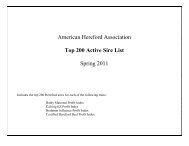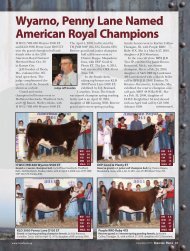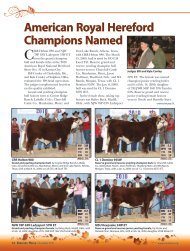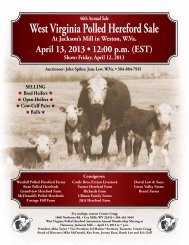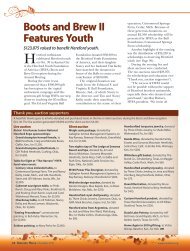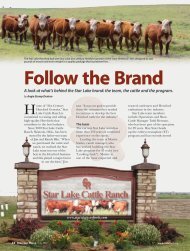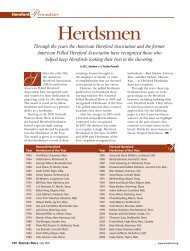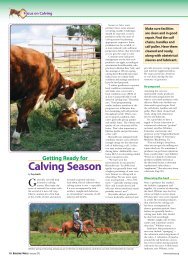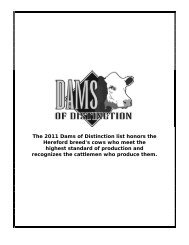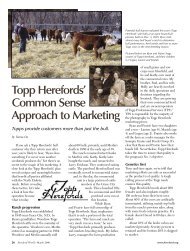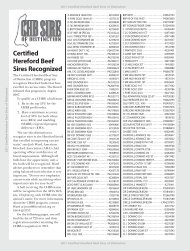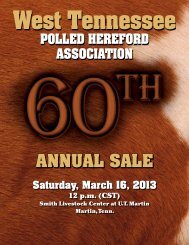Hereford Provides Improvement Opportunity
Hereford Provides Improvement Opportunity
Hereford Provides Improvement Opportunity
You also want an ePaper? Increase the reach of your titles
YUMPU automatically turns print PDFs into web optimized ePapers that Google loves.
<strong>Hereford</strong><br />
<strong>Provides</strong><br />
<strong>Improvement</strong><br />
<strong>Opportunity</strong><br />
Sierra Ranches turned to <strong>Hereford</strong> genetics to maximize calf-crop potential from its Angus-based cows.<br />
by Sara Gugelmeyer, photos by Angie Stump Denton<br />
It was time to make a change. After nearly 20 years of<br />
primarily using Angus bulls on his originally crossbred<br />
cow herd, Tim Coleman, owner of Sierra Ranches, knew it<br />
was necessary. He chose to add <strong>Hereford</strong> bulls to his program<br />
in 2009 and says it was a wise decision.<br />
“In order to<br />
improve the herd,<br />
crossbreeding<br />
seemed the most<br />
logical way to<br />
move forward with<br />
creating a better<br />
quality product, as<br />
well as achieving the<br />
heterosis that was<br />
much needed.”<br />
— Tim Coleman<br />
Tim Coleman founded Sierra<br />
Ranches in 1992 as a purebred<br />
Angus operation near Modesto,<br />
Calif. After all, Angus was<br />
what he knew — his parents are<br />
Jim and Sue Coleman of the<br />
acclaimed Vintage Angus Ranch.<br />
In 1994 he expanded into the<br />
commercial cow business.<br />
He says, “The goal of our<br />
cattle operation is to enhance<br />
the maternal traits of our<br />
cow herd, as well as improve<br />
the performance and carcass<br />
quality. We are fortunate in the<br />
fact that we have purebred and<br />
commercial experience, which<br />
helps us utilize the best genetics,<br />
while we are able to validate<br />
our calves at each stage<br />
of production.”<br />
Sierra Ranches’<br />
manager, Kevin McKinzie,<br />
confirms this approach saying<br />
that although the operation<br />
is commercial, he runs it<br />
with a purebred mindset and<br />
management style.<br />
Originally the cow herd<br />
was comprised of Angus and<br />
Charolais-<strong>Hereford</strong> cross cows.<br />
Then for about 15 years or<br />
more, Coleman bred them<br />
to Angus bulls and retained<br />
replacement females.<br />
He says during this time<br />
he would, on occasion, come<br />
across an article or speak with<br />
a longtime rancher touting the<br />
benefits of crossbreeding.<br />
Moving forward<br />
Coleman says, “In order to improve<br />
the herd, crossbreeding seemed the<br />
most logical way to move forward<br />
with creating a better quality<br />
product, as well as achieving the<br />
heterosis that was much needed.”<br />
So, in 2009 Coleman bought<br />
two yearling <strong>Hereford</strong> bulls<br />
and has been expanding the<br />
number of bulls used ever since.<br />
Currently, Sierra Ranches splits its<br />
cow herd in half, using <strong>Hereford</strong><br />
bulls on the straight Angus cows<br />
and the Angus bulls on the<br />
remaining cow herd.<br />
“The influence of <strong>Hereford</strong><br />
genetics is very complementary<br />
to our commercial cow-calf<br />
program,” he says.<br />
“By using the two-breed<br />
approach to mate each cow to<br />
the appropriate breed sire we<br />
can continue this crossbreeding<br />
method year after year. The<br />
maternal traits, performance,<br />
longevity and temperament are<br />
all benefits that we expect to<br />
continue to improve on our herd.”<br />
McKinzie explains that they<br />
use a fall-calving program,<br />
calving during a 60-75 day season<br />
between Aug. 1 and Oct. 15.<br />
The best heifers are chosen for<br />
continued on page 38...<br />
Quality <strong>Hereford</strong> bulls add much-needed heterosis to Sierra Ranches’ primarily Angus herd.<br />
<strong>Hereford</strong>.org October 2012 / 37
...<strong>Hereford</strong> <strong>Provides</strong> <strong>Improvement</strong> <strong>Opportunity</strong> continued from page 37<br />
“The <strong>Hereford</strong> bulls stick to their cows; they stay to their group.”<br />
— Kevin McKinzie<br />
replacements, and the rest of the<br />
calves are sold at weaning or sent<br />
to the Midwest to be fed out.<br />
Coleman says, “Our cattle<br />
have done extremely well<br />
performing in the feedlot, and<br />
on the carcass grids. Therefore,<br />
we have a good understanding<br />
of the carcass quality of our<br />
cow herd. Moving forward,<br />
we will continue to monitor<br />
and measure the progress of<br />
our cattle as they mature with<br />
generations to come.”<br />
<strong>Hereford</strong> advantages<br />
The <strong>Hereford</strong> advantage starts<br />
with the bulls themselves.<br />
McKinzie says he appreciates the<br />
docility and ease of handling with<br />
the <strong>Hereford</strong> bulls.<br />
McKinzie likes the way the<br />
<strong>Hereford</strong> bulls stay out of trouble.<br />
“The <strong>Hereford</strong> bulls stick to their<br />
cows; they stay to their group.<br />
“The big thing you hear about<br />
with <strong>Hereford</strong>s is their docility,<br />
they’re gentle, they’re calm, but<br />
they’re doing their jobs. When<br />
I handle them outside of the<br />
breeding season, when I’ve got<br />
them in my bull pasture, they<br />
are just gentle. I can go out and<br />
gather horseback any one I want<br />
on a 5,000-acre ranch and walk<br />
them right into the corral. The<br />
management practices and being<br />
able to work with the <strong>Hereford</strong><br />
cattle is sure appealing; they make<br />
my job a lot easier.”<br />
Coleman adds that he<br />
appreciates many traits <strong>Hereford</strong><br />
bulls possess. “They are very<br />
hardy, maintaining condition<br />
throughout the breeding season.<br />
They travel the country and stay<br />
sound and the added bonus is<br />
their excellent temperament.”<br />
Valuable diversity<br />
Although Sierra Ranches just has<br />
its third <strong>Hereford</strong>-sired calf crop<br />
on the ground, Coleman and<br />
McKinzie both are happy with the<br />
results. “So far so good,” Coleman<br />
says. “Our plan is to increase the<br />
number of baldie replacement<br />
heifers and add to our cow herd,<br />
as well as market to local ranchers.<br />
Through my experience, it is real<br />
easy to find all black replacements<br />
at a sale barn, but it is very difficult<br />
to find even a small lot of good<br />
quality baldie replacements. This<br />
is another reason why I made the<br />
decision to use <strong>Hereford</strong> bulls, and<br />
to generate my own replacements.<br />
The diversity that the black baldie<br />
heifer brings to our cow herd is<br />
extremely valuable in my opinion.”<br />
McKinzie, with 22 years<br />
of experience in the cattle<br />
industry, says he thinks Sierra’s<br />
crossbreeding program is and will<br />
continue to be successful.<br />
“On a visual observation, I feel<br />
like the crossbreeding is working<br />
very good,” McKinzie says.<br />
“What people have done on the<br />
commercial side of things, using<br />
Angus for so long, then we put<br />
something else on those cows, like<br />
a <strong>Hereford</strong>, the calves just explode<br />
a little bit. Using another sire sure<br />
complements (these cows), so I<br />
think we’re seeing somewhat of a<br />
better performing individual in<br />
terms of the calf crop. They are<br />
good performing, healthy cattle.”<br />
Coleman and McKinzie<br />
both say the future looks bright<br />
for Sierra Ranches. In March<br />
Coleman purchased a National<br />
Reference Sire Program bull,<br />
H5 9027 Advance 161, at Harrell<br />
<strong>Hereford</strong> Ranch’s bull sale.<br />
Add that great bull to the other<br />
quality bulls Sierra Ranches has<br />
already purchased from Pedretti<br />
Ranches, El Nido, Calif., and<br />
Sonoma Mountain <strong>Hereford</strong>s,<br />
Santa Rosa, Calif., and it’s<br />
no doubt Coleman has an<br />
impressive <strong>Hereford</strong> bull battery.<br />
McKinzie says, “We’re trying to<br />
grow with it. We appreciate both<br />
breeds, but really maximizing our<br />
calf value is the primary focus on<br />
how we breed cattle. We want to<br />
maximize the potential of our calf<br />
crop each year.”<br />
And for Sierra Ranches,<br />
adding <strong>Hereford</strong> genetics was the<br />
best way to do that. HW<br />
McKinzie says the <strong>Hereford</strong>-Angus cross has created a better performing calf.<br />
<strong>Hereford</strong> bulls’ advantage in docility and ease of handling is much appreciated.<br />
38 / October 2012 <strong>Hereford</strong>.org



